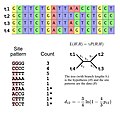The rate of evolution is quantified as the speed of genetic or morphological change in a lineage over a period of time. The speed at which a molecular...
20 KB (2,497 words) - 10:57, 1 April 2023
rate Mutation frequency Dysgenics Allele frequency Rate of evolution Genetics Cancer Scally A (December 2016). "The mutation rate in human evolution and...
28 KB (3,330 words) - 01:43, 17 April 2025
predicted to appear as a stable lag of the mean trait value behind a moving environmental optimum, where the rate of evolution and change in the environment...
16 KB (1,805 words) - 07:20, 12 November 2024
within the order. The rate of evolution within the genus has been slow, and almost all its species had become extinct by the end of the Pliocene. The sole...
15 KB (1,623 words) - 05:15, 18 April 2025
rate of eye evolution is difficult to estimate because the fossil record, particularly of the lower Cambrian, is poor. How fast a circular patch of photoreceptor...
46 KB (5,486 words) - 02:09, 7 April 2025
Quantum evolution is a component of George Gaylord Simpson's multi-tempoed theory of evolution proposed to explain the rapid emergence of higher taxonomic...
10 KB (1,156 words) - 14:06, 24 March 2023
evolution at individual codons in a set of nucleotide sequences to vary in an autocorrelated manner. Under the covarion model, the rates of evolution...
4 KB (458 words) - 08:46, 2 June 2022
these theories is that the rate of evolution of stars depends on their mass: The greater the mass, the faster this evolution, and the more quickly it leaves...
2 KB (251 words) - 19:44, 4 December 2024
Saltation (biology) (category Rate of evolution)
scientists of the period had written that saltational evolution was possible. Étienne Geoffroy Saint-Hilaire endorsed a theory of saltational evolution that...
30 KB (3,683 words) - 18:00, 28 January 2025
Evolution is the change in the heritable characteristics of biological populations over successive generations. It occurs when evolutionary processes...
240 KB (25,072 words) - 02:22, 7 May 2025
increased genetic variation, which led to an increased rate of evolution and the diversification of eukaryotes.[citation needed] Butterfield, Nicholas J...
3 KB (207 words) - 20:24, 27 November 2024
Adaptation (redirect from Adaptive Evolution)
selection. Adaptation is related to biological fitness, which governs the rate of evolution as measured by changes in allele frequencies. Often, two or more species...
75 KB (8,239 words) - 17:10, 15 May 2025
Moran process (section Rate of evolution)
simply be given by the mutation rate multiplied by two times the time since divergence. Thus the neutral theory of evolution provides a molecular clock, given...
19 KB (4,769 words) - 20:43, 23 February 2025
The history of molecular evolution starts in the early 20th century with "comparative biochemistry", but the field of molecular evolution came into its...
31 KB (4,143 words) - 23:08, 28 September 2024
A short-rate model, in the context of interest rate derivatives, is a mathematical model that describes the future evolution of interest rates by describing...
27 KB (3,723 words) - 07:41, 9 April 2025
terms of the parameters used to describe the rates at which one nucleotide replaces another during evolution. These models are frequently used in molecular...
36 KB (6,331 words) - 11:14, 30 December 2024
EDGE (telecommunication) (redirect from Enhanced Data Rates for Global Evolution)
Enhanced Data rates for GSM Evolution (EDGE), also known as 2.75G and under various other names, is a 2G digital mobile phone technology for packet switched...
21 KB (2,411 words) - 12:22, 23 March 2025
Anagenesis (redirect from Gradual evolution)
equilibria hypothesis suggests that anagenesis is rare and that the rate of evolution is most rapid immediately after a split which will lead to cladogenesis...
15 KB (1,838 words) - 23:30, 2 April 2025
Ancestral reconstruction (section Character evolution)
amount of evolution that has occurred on that branch will be underestimated for a given length of the branch and assuming a constant rate of evolution for...
115 KB (13,030 words) - 04:07, 16 December 2024
organisms at about 760–1060 Ma on the basis of comparisons of the rate of evolution in closely related groups. For much of the Paleozoic Era (542–251 Ma), the...
27 KB (2,967 words) - 10:49, 6 October 2024
Gradualism (redirect from Gradation model of evolution)
most evolution is marked by long periods of evolutionary stability (called stasis), which is punctuated by rare instances of branching evolution. Phyletic...
10 KB (1,238 words) - 15:43, 24 September 2024
mainly fossils. In biology, evolution is any change across successive generations in the heritable characteristics of biological populations. Evolutionary...
84 KB (4,812 words) - 03:52, 17 May 2025
Experimental evolution is the use of laboratory experiments or controlled field manipulations to explore evolutionary dynamics. Evolution may be observed...
49 KB (5,497 words) - 03:39, 7 April 2025
Punctuated equilibrium (redirect from Punctuated evolution)
confusion regarding rates of change. His first point is to argue that phyletic gradualism—understood in the sense that evolution proceeds at a single...
52 KB (5,650 words) - 00:06, 12 April 2025
method produces unrooted trees, but it does not assume a constant rate of evolution (i.e., a molecular clock) across lineages. The UPGMA (Unweighted Pair...
14 KB (2,012 words) - 01:09, 29 April 2025
Canine parvovirus (section Infection of the fetus)
receptor, the canine transferrin receptor. CPV2 has a high rate of evolution, possibly due to a rate of nucleotide substitution that is more like RNA viruses...
30 KB (3,495 words) - 05:38, 13 April 2025
latter that in fact sets the maximal rate of evolution by natural selection. More recent "travelling wave" models of rapid adaptation derive a term called...
20 KB (2,477 words) - 03:20, 17 March 2025
a group of organisms related by a specific tree. Stationary, neutral, independent, finite sites models (assuming a constant rate of evolution) have two...
65 KB (8,854 words) - 00:54, 29 April 2025
Living fossil (section Evolution and living fossils)
Cretaceous period) and, to the extent that they exhibit low rates of morphological evolution, extant species qualify as living fossils. It must be emphasised...
49 KB (5,114 words) - 01:50, 5 May 2025
Shaw; F. Helen Rodd; Ruth G. Shaw (1997). "Evaluation of the Rate of Evolution in Natural Populations of Guppies (Poecilia reticulata)". Science. 275 (5308):...
245 KB (27,677 words) - 20:52, 3 May 2025












